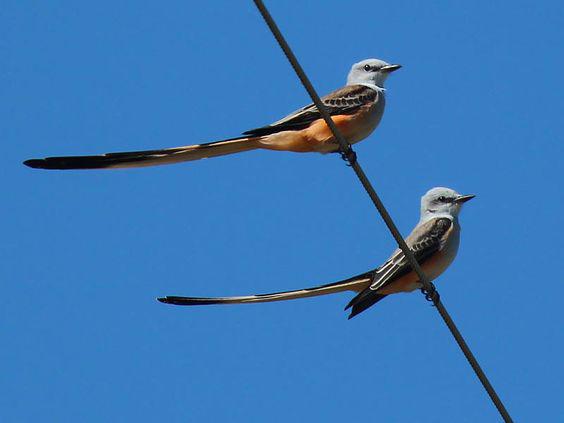
Ah… the Scissor-tailed Flycatcher — a vision of elegance, adorned in peachy flanks, a proud crest, and, most seductively, a pair of ribbon-like tail feathers that split and sweep behind it like silk lingerie in the southern breeze.
It is late spring, and the plains of Texas have become nature’s boudoir. The males take to the skies with theatrical flair, launching into acrobatic spectacles — barrel rolls, swooping dives, wing-snapping thrusts midair — all to impress the watching females. It is not just a courtship… it is an aerial striptease in feathers.
With his split tail splayed wide, the male flaunts himself in the thermals like a feathered flamenco dancer on heat, each twist and turn whispering, “I am virile. I am vigorous. I am airborne ecstasy incarnate.”
Should a female succumb to his airborne ballet, a pair is formed. They do not waste time — within a matter of days, she builds a cup-shaped nest, often high in a tree or even atop utility poles, weaving grasses and human trinkets — a tapestry of biology and banality. Here, she lays 3 to 6 eggs, often bluish-white with dark speckles — like delicate works of lustful porcelain.
Incubation takes about 13–15 days, and then… the hatching. Naked, blind, and desperate, the chicks emerge — tiny testaments to tail-feathered temptation. Both parents feed them dutifully, as they remain in the nest for roughly 14 to 17 days before taking flight — their first foray into a world ruled by performance and pheromones.
Now, if you’ll permit me… a brief detour to the high latitudes — to the Arctic Tern, that icy-winged Don Juan of the poles.
The Arctic Tern engages in a love story written across hemispheres. It migrates an astonishing 25,000 miles each year — the longest migration of any animal on Earth — chasing eternal summer, and perhaps, eternal seduction.
Come June in the Arctic Circle, the icy air fills with their piercing calls. The male initiates his courtship by offering a gift — not chocolates or roses, but the shimmering body of a freshly caught fish, held in his beak like a dangling, salty innuendo.
Should the female be enticed by his piscine prowess, she will accept it with a coy bob of the head — and then, with talons clasped midair, the pair spirals downward in a climactic tumble of feathers and frictionless union.
Their nests are modest — shallow scrapes in the tundra, lined with bits of moss and shell. The female lays 1 to 3 eggs, pale with speckles, like forgotten pearls on a frozen shore. Both parents share duties of incubation — about 21 to 23 days — and fiercely defend their clutch, dive-bombing intruders with blood-curdling shrieks and dagger-sharp beaks.
You see, in both species — whether the sky-stripping flycatcher of the South, or the globe-trotting tern of the North — love is not gentle. It is theatrical. It is precise. It is feathered frenzy and wild devotion, written on the wind.
And in that exquisite chaos of courtship, eggs, and eternity — life flutters on.